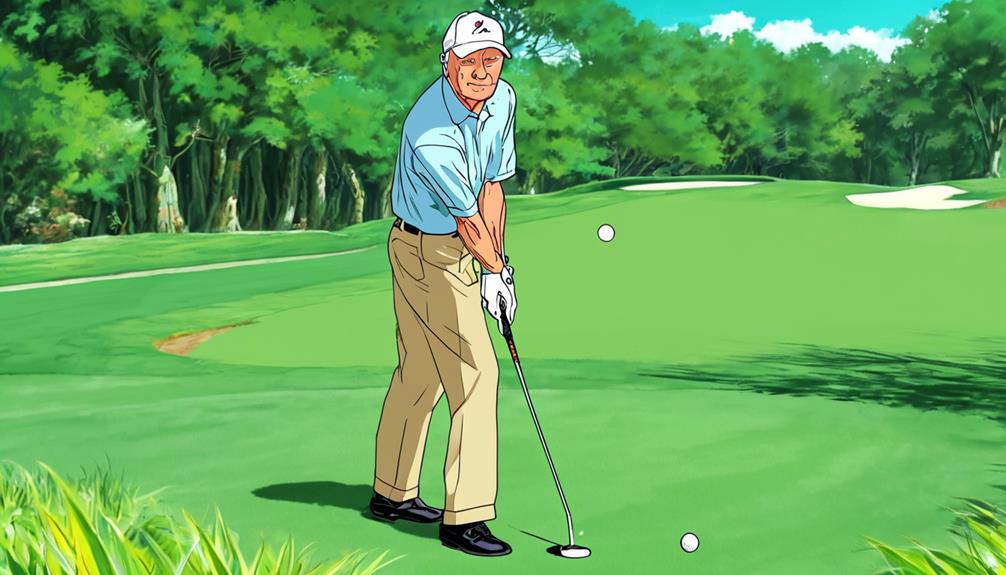

Are you tired of struggling on the golf course, never quite achieving the level of success you desire?
Well, get ready to revolutionize your game with these 7 game-changing golf tips from the legendary Arnold Palmer.
With his expertise and experience, Palmer has honed in on the key elements that can truly transform your performance on the green.
From perfecting your grip and stance to mastering the mental approach, these tips will take your game to a whole new level.
So, get ready to uncover the secrets that will have your fellow golfers wondering what on earth happened to your swing.
Key Takeaways
- Proper grip and hand positioning are essential for control and preventing clubface issues.
- Shot selection should be based on target analysis, club selection, and consideration of course conditions.
- Club selection and course management should take into account the layout, hazards, distances, and wind direction.
- Reading greens and assessing risks can lead to better decision-making and improved performance.
Grip and Stance


To improve your golf game, it’s crucial to master the proper grip and stance, as they lay the foundation for a successful swing.
The grip is your connection to the club, influencing the direction and power of your shots. A proper grip starts with positioning the club in the fingers of your lead hand, while the trail hand supports and aligns with the lead hand. This neutral grip allows for better control and prevents the clubface from opening or closing too much during the swing.
Equally important is your stance, which affects balance, stability, and weight distribution. Proper alignment is key, as it ensures that your body is positioned parallel to the target line. To achieve this, stand with your feet shoulder-width apart, toes pointing slightly outward. The lead foot should be flared open, while the trail foot is perpendicular to the target line.
As for weight distribution, it should be evenly balanced between both feet, with a slight bias towards the balls of your feet. This helps maintain stability throughout the swing and allows for a more powerful and accurate strike.
Power and Distance


Improving your power and distance on the golf course requires a combination of technique, strength, and proper club selection. Increasing swing speed is crucial in generating more power and distance. To achieve this, focus on your body rotation and weight transfer during your swing.
A proper shoulder turn, accompanied by a smooth transition of weight from back foot to front foot, can significantly increase clubhead speed. Additionally, incorporating exercises to enhance your core and lower body strength can help maximize your swing speed.
Improving accuracy is equally important when it comes to power and distance. A powerful swing alone won’t guarantee success if you consistently miss your target. One way to improve accuracy is by maintaining a consistent swing tempo and rhythm. Rushing your swing can lead to mis-hits, while a controlled and smooth swing can enhance your chances of hitting the ball accurately.
Another key aspect of improving accuracy is selecting the right club for each shot. Consider factors such as the distance to the target, the lie of the ball, and the wind conditions. Choosing the appropriate club won’t only help you hit the ball with better accuracy but also optimize your power and distance.
Shot Selection


When it comes to shot selection in golf, there are three key points to consider:
- Target analysis: This involves studying the layout of the hole and identifying the best landing area for your shot. By analyzing the distance, hazards, and angles, you can determine the ideal target to aim for.
- Club selection: Choosing the right club is crucial because it determines the distance and trajectory of your shot. Considering factors such as the distance to the target, the lie of the ball, and the conditions of the course can help you select the appropriate club for the shot.
- Course conditions: Taking into account the course conditions such as wind, slopes, and hazards can greatly impact your shot selection strategy. Adjusting your shot to accommodate for these factors can help you avoid obstacles and improve your chances of success.
Target Analysis
Understanding the art of target analysis is essential for making precise and strategic shot selections on the golf course. By analyzing the target, you can determine the best approach to take and increase your chances of hitting the ball where you want it to go. Here are four key aspects to consider when conducting target analysis:
- Distance: Assess how far the target is from your current position. This will help you choose the appropriate club and adjust your swing mechanics accordingly.
- Hazards: Identify any potential obstacles, such as bunkers, water hazards, or trees, that may affect your shot. Take these into account to avoid unnecessary risks.
- Slopes: Evaluate the slope of the terrain surrounding the target. This will impact the ball’s trajectory and roll after landing, influencing your shot selection.
- Wind: Consider the direction and strength of the wind. Adjust your aim and shot selection accordingly to compensate for wind resistance.
Club Selection
To make informed decisions on the golf course, your shot selection plays a crucial role in determining the club you choose to use. Course navigation and shot accuracy are key factors to consider when selecting the right club for each shot.
Proper club selection can greatly impact the outcome of your game. When navigating the course, take into account the layout, hazards, and distances. Analyze the terrain and consider the wind direction. This will help you determine the optimal club to use for each shot.
Additionally, shot accuracy is essential for success. Choosing the right club that suits your skill level and abilities can improve your chances of hitting the ball accurately and achieving your desired result.
Course Conditions
Properly assessing course conditions is a vital aspect of shot selection in golf, as it allows you to adapt your strategy and choose the most effective club for each shot. Here are four factors to consider when evaluating course conditions:
- Weather Impact: Take into account the current weather conditions, such as wind direction and speed, temperature, and precipitation. These elements can significantly affect the flight and distance of your shots. Adjust your strategy accordingly to optimize your performance.
- Turf Management: Pay attention to how the course is maintained. Factors like the firmness of the fairways, the speed of the greens, and the condition of the rough can impact the type of shot you choose. Adapt your approach based on the course’s turf management to maximize your chances of success.
- Course Topography: Consider the layout and features of the course. Are there slopes, water hazards, or bunkers that could influence your shot selection? Understanding the course’s topography will help you make informed decisions on where to aim and which club to use.
- Course Conditions Throughout the Day: Keep in mind that course conditions can change as the day progresses. Factors like moisture, temperature, and foot traffic can alter the playing surface. Stay observant and adjust your strategy accordingly to maintain consistency throughout your round.
Course Management


When it comes to course management, there are several key components that golfers should consider.
One important aspect is strategic shot selection. Arnold Palmer, a legendary golfer, emphasizes the importance of carefully considering options and choosing the shot that will give the best chance of success. This involves evaluating factors such as distance, wind conditions, and hazards present on the course.
Another crucial element is reading the greens. This involves assessing the speed and break of the putt accurately. By carefully observing the slope and texture of the green, golfers can make better decisions on how to approach their putts and improve their chances of sinking them.
Lastly, assessing the risks involved in each shot can help golfers make smart decisions and avoid unnecessary trouble on the course. This includes considering the potential hazards and obstacles that may come into play and adjusting shot selection accordingly. By weighing the risks against the potential rewards, golfers can make more informed decisions and increase their chances of success.
Strategic Shot Selection
In order to navigate the golf course strategically, it’s crucial to make well-informed shot selections that take into account various factors such as the layout of the course, the weather conditions, and your own skill level. Here are four key considerations for making strategic shot selections:
- Course Strategy: Before teeing off, study the course layout and analyze its challenges. Identify the hazards, bunkers, and water bodies that may come into play. Plan your shots accordingly to avoid unnecessary risks and maximize your chances of success.
- Shot Placement: Instead of always going for the longest shot possible, focus on accurate shot placement. Consider the pin placement and aim for the optimal position on the fairway or green. This will set you up for easier approach shots and potential birdie opportunities.
- Weather Conditions: Take into account the wind direction and speed, as well as the firmness or softness of the ground. Adjust your shot selections accordingly to compensate for these factors and achieve the desired outcome.
- Skill Level: Be realistic about your own abilities. Choose shots that match your skill level and comfort zone. It’s better to play it safe and consistently execute shots within your capabilities rather than attempting risky shots that may lead to costly mistakes.
Reading the Greens
To effectively manage the course and make accurate putts, understanding how to read the greens is essential.
When it comes to reading greens, two important factors to consider are the green slope and speed control.
The green slope refers to the incline or decline of the putting surface, which can greatly affect the roll of the ball. By observing the contours and slopes of the green, you can determine the direction in which the ball will break.
Speed control, on the other hand, involves understanding the pace at which the ball should be struck to reach the hole. Analyzing the distance, uphill or downhill slopes, and the grain of the grass can help you gauge the appropriate speed for your putt.
Mastering these aspects of reading the greens will give you a significant advantage in navigating the course and sinking those crucial putts.
Risk Assessment
Understanding how to effectively assess the risks on the golf course is crucial for strategic and successful course management. When it comes to risk management and decision making in golf, there are a few key points to keep in mind:
- Analyze the situation: Take the time to assess the potential risks and rewards of each shot. Consider factors such as distance, obstacles, and weather conditions before making your decision.
- Play to your strengths: Identify your strengths and weaknesses as a golfer and use that knowledge to make informed decisions. If you know you have a strong short game, for example, consider taking a more aggressive approach when faced with a risky shot.
- Take calculated risks: It’s important to take risks in golf, but they should be calculated ones. Consider the potential outcomes of your shot and weigh the risks against the rewards before committing to a decision.
- Trust your instincts: Sometimes, you have to trust your gut and go with your instincts. If you have a strong feeling about a particular shot or strategy, don’t be afraid to take a chance and see how it pans out.
Mental Approach


Developing a strong mental approach is crucial to achieving success on the golf course. Arnold Palmer, a legendary figure in the world of golf, understood the importance of a positive mindset, focus, and concentration. To truly excel in the game, you must cultivate a mental state that allows you to stay calm and composed in the face of challenges.
A positive mindset is essential because it enables you to approach each shot with confidence and belief in your abilities. It helps you stay motivated and bounce back from setbacks, allowing you to maintain a steady performance throughout the game. Arnold Palmer emphasized the power of positive thinking, urging golfers to visualize success and trust in their skills.
In addition to a positive mindset, focus and concentration are vital aspects of the mental game. Golf requires precision and accuracy, and these can only be achieved when you’re fully focused on the task at hand. By blocking out distractions and honing your concentration, you can make better decisions and execute shots with greater precision.
Arnold Palmer believed that the mental aspect of golf played a significant role in determining success. By developing a strong mental approach, you can enhance your performance on the golf course and achieve the results you desire. Remember to maintain a positive mindset, stay focused, and concentrate on each shot, and you’ll be on your way to becoming a better golfer.
Why Is Tiger Woods’ Golfing Legacy Unraveling?
Short Game Mastery


As you strive to cultivate a strong mental approach on the golf course, one area where your skills can truly shine is in the mastery of the short game. Arnold Palmer, a legend in the sport, understood the importance of honing your putting technique and chipping skills to gain a competitive edge. Here are four game-changing tips to help you excel in your short game:
- Putting Technique: Focus on your alignment, grip, and stroke. Ensure that your body is properly positioned, your grip is relaxed yet firm, and your stroke is smooth and consistent. Practice distance control by experimenting with different lengths of backswing and follow-through.
- Chipping Skills: Develop a variety of shots for different situations. Master the basic chip shot by using a narrow stance, keeping your weight forward, and making a controlled pendulum swing. Experiment with different clubs and techniques to handle various lies and obstacles around the green.
- Visualization: Imagine the ball rolling into the hole as you line up your putt or visualize the trajectory of your chip shot. This mental imagery helps build confidence and enhances your ability to execute the shot effectively.
- Practice Under Pressure: Simulate game-like situations during practice by setting goals, creating pressure, and focusing on specific scenarios. This will help you develop a calm and composed mindset when faced with challenging short game shots during a round.
Pioneering Golf Greatness: Tiger Woods’ Timeless Impact
Putting Precision


To achieve precision in your putting, focus on refining your technique and mastering the fundamentals. Putting is a crucial aspect of the game that can make or break your score, so it’s important to develop a solid foundation.
One key element to consider is alignment techniques. Proper alignment ensures that your putter face is square to the target line, giving you the best chance of sinking the putt. One popular alignment method is the ‘railroad track’ technique, where you imagine two parallel lines extending from your ball to the target. Align your putter face with the inner line and your feet with the outer line, creating a consistent setup.
Another vital aspect of putting precision is speed control. The speed at which you hit the ball directly affects its path and distance. Remember, the goal is to get the ball to the hole, not past it. To improve your speed control, focus on the length of your backswing and the tempo of your stroke. A shorter backswing with a smoother tempo can help you maintain control and consistency.
Frequently Asked Questions
3 Best Moments in Tiger Woods’ Legendary Journey
How Can I Improve My Swing Speed to Increase Power and Distance?
Want to increase your swing speed, power, and distance in golf? Follow Arnold Palmer’s tips to improve your swing speed. Get ready to crush the ball and see those shots fly farther than ever before!
What Factors Should I Consider When Selecting the Right Club for a Particular Shot?
When choosing the perfect club for a shot, consider factors like distance, wind, and course conditions. Don’t forget to avoid common swing speed mistakes that can affect your accuracy and control.
What Are Some Effective Strategies for Managing the Course and Playing to My Strengths?
When it comes to managing the course and playing to your strengths, there are a few key strategies to keep in mind. By carefully assessing the layout and leveraging your skills, you can optimize your performance and achieve better results.
What Is Arnold Palmer’s Impact on Modern Golfers?
How Can I Develop a Strong Mental Approach to Stay Focused and Perform Well Under Pressure?
To develop a strong mental approach and perform well under pressure, focus on visualization techniques to enhance your concentration and performance. Practice breathing exercises to stay calm and composed when faced with challenging situations on the course.
Are There Any Specific Techniques or Drills I Can Practice to Improve My Putting Precision?
To improve your putting accuracy, try incorporating specific putting drills into your practice routine. These drills will help you develop better control and precision on the greens, ultimately leading to better scores on the course.
Conclusion
In conclusion, Arnold Palmer’s game-changing golf tips offer invaluable insights into the sport. His mastery of grip and stance, power and distance, shot selection, course management, mental approach, short game, and putting precision can revolutionize any golfer’s performance.
Just like Palmer’s famous drive on the 16th hole at Augusta National, these tips have the potential to launch your game to new heights, leaving a lasting impact on both your scorecard and your heart.
Discover Arnold Palmer’s Legendary Golfing Secrets: Take the Quiz








